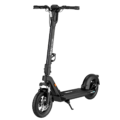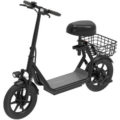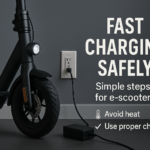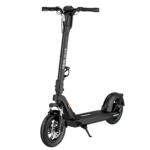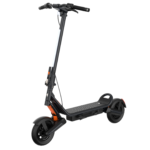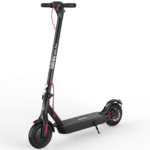- Home
- Scooters
- Electric Scooters
- Hiboy S2 SE
Hiboy S2 SE




- Battery Range: 17 mi (27 km)
- Top Speed: 19 mph (30.6 km/h)
- Motor Power: 350 W nominal
- Weight Capacity: 37.8 lb (17.1 kg)
- Charging Time: 36 V 7.8 Ah, ~5.5 h charge
- Scooter Weight: 37.8 lb (17.1 kg)
PROS
- Up to 17 miles range
- Mixed tires: flat-resistant + compliant
- E-brake + drum braking
- Bright lighting + side reflectors
- Fast fold; app basics; cruise toggle
CONS
- Heavier than some 36 V peers
- No suspension (tire compliance only)
- Range dips in cold/headwinds
- IPX4: avoid heavy rain

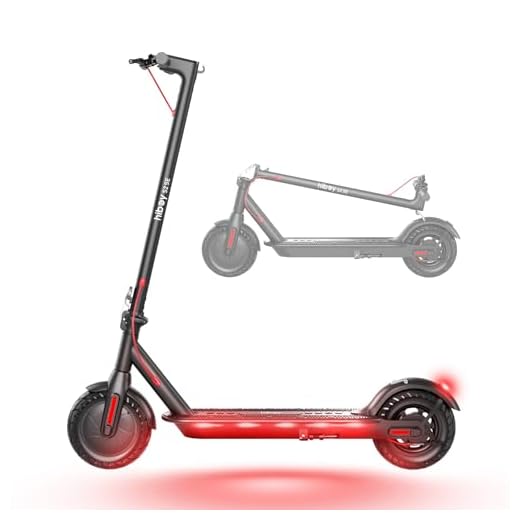
Overview: Hiboy S2 SE — Simple, Capable, and Ready to Commute
Quick take: steady, affordable, and easy to live with
The Hiboy S2 SE focuses on daily needs instead of flashy numbers. It delivers steady thrust, predictable braking, and a quick, confident fold. Furthermore, it keeps costs in check without feeling flimsy. A rear-hub 350 W motor pairs with a 36 V 7.8 Ah battery, and the scooter tops out around 19 mph in typical regions. Under favorable conditions, many riders see up to 17 miles of practical range. Because Hiboy mixes a solid 10-inch front tire with a pneumatic 10-inch rear, the S2 SE blends puncture resistance with comfort where you feel it most. As a result, you ride calmly, fold fast, and avoid constant tinkering.
From the first block, the S2 SE feels composed. The throttle ramps in smoothly rather than spiking. The chassis holds a straight line in busy bike lanes. Additionally, the low deck lowers your center of gravity, which steadies steering when pavement gets choppy. You do not need special technique to enjoy it. Instead, you stand, roll, and feel the morning routine lighten.
Who the S2 SE suits best
The S2 SE is for riders who value calm manners, clear braking, and minimal upkeep. New riders like the measured acceleration and stable feel. Returning riders appreciate the simple fold and the predictable cockpit. Commuters who board trams or use elevators enjoy the compact footprint. Apartment dwellers value straightforward storage and quick charging habits. In short, if your loop is short and your schedule tight, the S2 SE keeps friction low.
Because cities differ, needs differ as well. Some riders face gusty mornings, short grades, or patched asphalt. The S2 SE manages these variables with steady control. It is not a hill-climb specialist. However, it maintains momentum on modest rises if you approach with speed. On rough patches, the pneumatic rear softens chatter while the solid front shrugs off debris that would puncture tubes. Consequently, the scooter remains reliable, simple, and comfortable enough for daily use.
Design and build: tidy, rigid, and commuter-first
The frame mixes aluminum and Q235 steel into a tidy commuter chassis. The folding latch feels deliberate and locks with a clear snap. Moreover, the stem stays firm at neighborhood speeds. The deck grip is coarse enough for drizzle, and cable routing is clean. The bar layout leaves room for a bell and a compact phone mount, so the cockpit stays functional rather than flashy.
Why the mixed-tire setup matters
The solid 10-inch front tire resists punctures and never needs pressure checks. Meanwhile, the pneumatic rear adds compliance where your weight loads the chassis. That blend drops flat risk up front and preserves ride comfort in back. Even so, posture still helps. With bent knees and relaxed elbows, the scooter glides across patched asphalt and paver seams. Therefore, hands stay looser and shoulders stay relaxed on longer runs.
Motor and everyday speed: composed confidence
The 350 W rear-hub motor provides trustworthy thrust to a regulated top around 19 mph. Because the rear wheel drives, weight shifts onto the contact patch when you accelerate. That shift improves traction and keeps launches predictable. On clear paths, you climb to cruising speed without drama. In thicker traffic, you feather the throttle to match flow. Either way, the S2 SE rewards smooth inputs and steady planning.
Ride modes and cruise behavior
Mode selection stays simple. You toggle between Drive and Sport for most rides, with cruise behavior available where regional firmware supports it. On longer, quiet stretches, cruise reduces thumb fatigue and can help range. Use it thoughtfully—stay alert, keep a finger near the brake, and disengage early when conditions change. Consequently, you gain comfort without losing control.
Battery, range, and charging: honest numbers, simple habits
The 36 V 7.8 Ah pack matches the motor well. On flat paths, moderate speeds, and light winds, many riders see 12–17 miles per charge. Heavy riders, strong headwinds, and winter temperatures reduce that figure. Planning helps. Pick calmer routes with fewer stops, and range stabilizes. Moreover, riding at 12–15 mph stretches distance far more than sprint-and-brake patterns.
Charging from low typically takes about five and a half hours. Therefore, overnight top-ups become easy, and midday desk charges remain realistic. Store the scooter at room temperature, and avoid leaving the pack at 100% for weeks. If you pause riding, park near half charge and check monthly. These small habits preserve capacity and keep range predictable through winter.
Range-boosting micro-habits
Look ahead and coast early into reds. Choose smoother lanes even if they add a minute. Keep loads centered and low in a backpack or stem bag. On windy days, narrow your profile and stay relaxed. Together, these tweaks add miles without costing time.
Braking and safety: consistent stops in dry and wet
The S2 SE uses a front electronic brake and a rear drum. Drums live inside the hub, so grit and spray matter less. Lever feel stays familiar in the wet, and shoes last a long time. Meanwhile, the electronic brake provides gentle regen and smooth trimming in traffic. Practice progressive braking in a quiet lot. Load the front with your body, apply both systems together, and lengthen distances on damp days. That routine turns emergencies into routine maneuvers.
Lighting and conspicuity
Lighting is clear for the class. A bright headlamp illuminates your line at neighborhood speeds. The rear light doubles as a brake light, while reflectors increase passive side visibility. For rural shortcuts, add a clip-on rear flasher to your bag and consider a helmet-mounted light to aim through turns. Visibility equals safety. Fortunately, lightweight lights punch far above their cost.
Ride quality and comfort: stable chassis, low deck, smart tires
Comfort flows from stability and posture. The pneumatic rear filters high-frequency buzz, so your hands stay relaxed. The solid front holds a firm line and resists pinch flats on curbs. On cobbles, slow down and flex your legs to add suspension. On smooth bike lanes, enjoy a calm, even pace. Additionally, switch your lead foot on longer rides and keep elbows soft. Those small choices reduce fatigue and make the scooter feel planted.
Ergonomics that reduce fatigue
Set lever angle so your wrist stays neutral. Place the display where you can glance without turning your head. Keep cable loops smooth and out of the way. Because these details shape comfort, they also shape safety. A neutral posture preserves fine control when bumps arrive suddenly.
Portability and storage: quick fold, compact footprint
The S2 SE weighs about 37.8 lb. It is not feather-light. Nevertheless, the fold is fast, the latch is positive, and the package fits through tight doors and into lifts. On stairs, grab the stem near the clamp and the deck at its balance point. On trains, rotate the bar inward so the deck parallels the wall. At the office, park beside a desk where permitted and plug in discreetly. At home, store indoors away from heaters and direct sun. After wet rides, wipe the scooter dry and let it breathe before stowing.
Small space tactics
Use a narrow wall hook or compact floor stand to tame the footprint. Turn the bar in so the deck sits parallel to the wall. Consequently, hall traffic flows and scuffed paint stays rare.
Smart features and app: simple tools that help
The LED dashboard presents speed, battery, and mode clearly. The app adds an electronic lock, cruise toggles, and ride statistics. The lock deters casual roll-aways during coffee stops. For longer errands, add a compact physical lock through a fixed object where local rules allow. Firmware updates arrive periodically and may refine throttle curves or regen feel. Keep the app current to benefit from those small improvements.
Phone mounting and distraction control
A rigid, mechanical phone clamp beats elastic bands on cobbles. Mount where you can glance without moving your chin. Even then, keep eyes on the path. Check maps at lights or safe pull-outs. As a result, you gain navigation while protecting attention.
Weather and seasonal tips: safer choices, longer life
Light rain rides are manageable with care. Reduce speed, extend braking distance, and avoid sharp angles across paint or metal. The IPX4 rating protects against splashes, not submersion. After wet rides, wipe the scooter and check drum lever feel. In winter, store and charge indoors. Expect temporary range dips below 10 °C as cells deliver less energy. Plan conservative routes on cold days and top up at work if needed. In summer, avoid leaving the scooter in parked cars; heat ages cells and plastics quickly.
Maintenance and ownership: five minutes that save money
Ownership is straightforward. Check the folding latch monthly and keep the hinge clean. Inspect brake feel and drum engagement. Verify fasteners on bar, stem, and deck are snug. Keep the rear tire at its recommended pressure and the front tire clean. Lubricate the latch lightly, not the brake. These tiny steps keep the scooter quiet, tight, and pleasant to ride.
Troubleshooting fast fixes
If the scooter fails to power on, confirm charger function, outlet power, and battery level. If the drum feels weak, check cable tension and leverage at the arm; a small adjustment often restores bite. If range drops in cold weather, warm the scooter indoors and charge fully; capacity rebounds at room temperature. If the latch creaks, clean grit and retighten fasteners. These checks solve most day-to-day snags.
Accessories that add real value
Small add-ons deliver big returns:
- A bright bell for polite passes on shared paths.
- A compact, high-output headlight plus a clip-on rear flasher for dusk.
- Thin full-finger gloves for shoulder seasons and better grip.
- A rigid phone mount with a mechanical clamp for maps.
- A small stem bag for a lock, charger, and cable.
Furthermore, keep the cockpit tidy so your hands wrap cleanly around the grips. Clear controls improve emergency handling and reduce accidental inputs.
S2 SE vs KS4 vs KS4 Pro: choose by route, not hype
Compared with the KS4, the S2 SE trades to a drum brake and adds a pneumatic rear tire for comfort. Compared with the KS4 Pro, it remains lighter and more affordable but offers less battery capacity and smaller overall tire volume than the Pro’s 10-inch pair. If your distances are short and your surfaces mixed, the S2 SE is compelling. If you often ride longer loops or want more range headroom, the KS4 Pro fits better. If you carry the scooter up stairs daily and need the lightest package, the KS4 earns a look. Therefore, pick based on route, storage, and charging plan—not brochure headlines.
Set-up and first ride: ten minutes that pay off
Unbox and verify that fasteners are snug. Charge to full before the first outing so the BMS can balance cells. Pair the app and skim the tutorial. Practice slow-speed starts, straight-line emergency stops, and gentle figure-eights in a quiet lot. Learn to shift your weight slightly rearward under braking and to bend your knees over rough patches. Ten minutes of drills build habits that last.
Etiquette and visibility: predictability wins
Ride predictably and share space graciously. Signal before passing and give room to walkers. Make eye contact with drivers at junctions. Mount the headlight slightly downward to avoid glare for oncoming riders. Wear brighter layers at dusk or clip reflective bands to your ankles. These choices increase safety and improve the experience for everyone on the path.
Real-world scenarios and how the S2 SE handles them
Campus connectors: Moving between buildings all day? The quick fold and calm throttle shine. Additionally, Drive mode keeps speeds courteous between classes.
Station sprints: Need to make a train? Sport mode reaches the cap briskly, and the compact fold fits on platforms without blocking doors.
Neighborhood errands: A bell plus a small stem bag streamline short stops at markets or parcel lockers. Meanwhile, the rear pneumatic tire keeps chatter down on patched streets.
Dusk rides on shared paths: Add a second headlight and a rear flasher. Consequently, you are visible from more angles and at longer distances.
Because the S2 SE adapts with simple mode changes and easy folding, it slots into varied days without fuss.
Buying checklist and “specifications” in context
Before you commit, run through a quick checklist:
- Measure storage space and confirm the folded footprint fits.
- Time your route at a relaxed pace and add a 20% range buffer.
- Identify your steepest hill and plan a steady climb, not sprints.
- Test lever reach and bar width if possible.
- Budget for a bright headlight, a decent lock, and gloves.
Yes, brochures and specifications matter. However, daily satisfaction comes from control feel, braking confidence, and storage ease. Therefore, match the scooter to four realities: distance, weather, storage, and charging. If those align, you will ride often. If one fails, you will ride less. The S2 SE hits a practical balance for many urban routes.
Seasonal care: small habits, big returns
Spring: Grit hides in hinges; wipe and re-lube latch points lightly.
Summer: Heat stresses cells; avoid hot car trunks and charge in shade.
Autumn: Wet leaves cut grip; brake earlier and avoid sharp lean on paint.
Winter: Cold reduces range; plan shorter loops and charge indoors.
After wet rides, wipe the deck, stem, and hinge. Additionally, avoid spraying the brake with lubricant. Thus, braking stays strong and squeal-free. With these habits, the scooter feels new far longer than you would expect.
Comfort tuning without mods
Handlebar roll and lever angle shape wrist comfort. Therefore, rotate the brake lever so your wrist stays neutral. Place the display where you can glance without turning your head. Keep cable loops smooth to prevent snags. Grip with relaxed fingers rather than a hard fist. Consequently, numbness fades and control improves on bumps. If hand fatigue lingers, add thin gloves; they weigh almost nothing yet damp micro-vibrations.
Final verdict: capable commuting, minimal fuss
The Hiboy S2 SE is built for daily reality. It moves with quiet confidence, stops with consistency, folds in seconds, and stores without fuss. It trades extreme speed for good manners and long-term simplicity. Moreover, it avoids common pain points: front-wheel flats, fussy setup, and heavy carries. Glance at the specifications once, then judge the scooter by your route, storage, and schedule. If those boxes are ticked, the S2 SE will earn a spot in your routine.
Summary highlights
- Motor & pace: 350 W rear-hub; composed launches; regulated ~19 mph.
- Battery & range: 36 V 7.8 Ah; about 12–17 miles under typical city use.
- Brakes: Front electronic assist with regen + rear drum for consistent wet-weather feel.
- Tires & comfort: 10″ solid front + 10″ pneumatic rear; fewer flats with real compliance.
- Portability: ~37.8 lb; quick, positive fold; compact for desks, trains, and elevators.
- Features: Clear LED display; app lock; cruise (region-dependent); clean cable routing.
- Best for: Riders who want calm manners, simple storage, and low upkeep on short commutes.
- Care tips: Monthly latch check, clean hinge, balanced charging habits, and sensible speeds in rain.
If you want longer range and bigger tires, consider the KS4 Pro. If you want the lightest carry and a very tight budget, look at the KS4. Otherwise, for day-to-day city hops with minimal fuss, the S2 SE is a smart, steady choice.
Specifications
General
| Model The Model specifies the exact version or name of the scooter. It helps identify its unique design, features, and specifications within the manufacturer’s product line. Knowing the model makes it easier to compare options, find compatible accessories, or look up support information. | S2 SE |
| Brand The Brand identifies the manufacturer or company that designs and produces the scooter. A trusted brand is a sign of quality, reliability, and good customer support. Well-known brands often have higher standards for safety, performance, and after-sales service, giving you more confidence in your purchase. | Hiboy |
| Release Date The Release Date indicates when the scooter model was officially launched on the market. This helps you know how current the design, technology, and features are. A newer release date often means updated components, improved performance, and the latest safety or smart features. | 17 November 2025 |
| Recommended Age Recommended Age indicates the minimum age range that the scooter is designed for, based on safety, size, and ease of use. Following the recommended age helps ensure that riders can handle the scooter’s speed, weight, and controls comfortably and safely. Always check local laws and use protective gear, especially for younger riders. | Recommended 16+ |
Performance & Power
| Motor Power (Wattage) What it means: The motor power, measured in watts (W), shows how strong the scooter’s electric motor is. Why it matters: Higher wattage usually means better acceleration, more torque, and improved performance on hills or rough terrain. For example, a 250W motor is good for flat city roads and light riders, while a 500W or 1000W motor provides more power for faster speeds or climbing steep inclines. | 350 W nominal (430 W peak) |
| Top Speed The Top Speed indicates the maximum speed that the scooter can reach under optimal conditions. It’s usually measured on level ground with a fully charged battery and an average rider weight. A higher top speed allows you to travel longer distances faster, but always ensure you ride within legal speed limits and your personal comfort zone for safety. | 19 mph (30.6 km/h) |
| Battery Capacity Battery Capacity refers to the total amount of energy the scooter’s battery can store, usually measured in ampere-hours (Ah) or watt-hours (Wh). A higher battery capacity means you can ride longer distances on a single charge, reducing the need for frequent recharging. Keep in mind that actual range can vary depending on rider weight, terrain, speed, and weather conditions. | 36 V 7.8 Ah |
| Estimated Range per Charge The Estimated Range per Charge indicates the average distance the scooter can travel on a single full battery charge. This range is calculated under optimal conditions, such as flat terrain, moderate speed, and average rider weight. Real-world range may vary depending on riding style, terrain, weather, and load. A longer range means fewer recharges and greater freedom for longer trips. | Up to 17 mi (27 km) |
| Hill Climb Ability Hill Climb Ability describes the maximum incline or slope that the scooter can handle while maintaining stable performance. It’s typically expressed as a percentage or in degrees. A higher hill climb rating means the scooter can tackle steeper hills without losing too much speed or power. Actual climbing performance may vary based on rider weight, battery charge, and terrain conditions. | Up to 15° grades |
| Drive System The Drive System refers to how power from the motor is delivered to the wheels. Electric scooters typically use either a hub motor (directly integrated into the wheel) or a chain/belt drive system. A high-quality drive system ensures smooth acceleration, efficient power transfer, and low maintenance. The choice of drive system affects performance, noise level, and overall ride experience. | Rear hub motor (RWD) |
Charging & Electrical
| Charging Time Charging Time indicates how long it takes to fully recharge the scooter’s battery from empty to 100% using the standard charger provided. Faster charging means less downtime and more time on the road. Actual charging time may vary slightly depending on battery capacity, charger output, and environmental conditions. | Approx. 5.5 hours |
| Battery Type Battery Type refers to the specific technology used in the scooter’s battery, which affects performance, lifespan, weight, and charging time. Most modern electric scooters use high-quality lithium-ion (Li-ion) batteries because they offer a good balance of energy density, durability, and low maintenance. A reliable battery type ensures consistent power delivery and longer riding ranges. | Li-ion with Smart BMS (UL2272) |
| Removable Battery A Removable Battery means the battery pack can be easily detached from the scooter for convenient charging and replacement. This feature allows you to charge the battery separately, swap it with a spare for extended range, or securely store it indoors in extreme weather. Removable batteries add flexibility and make it easier to keep your scooter powered up wherever you are. | No external fast charge |
| Regenerative Braking Regenerative Braking is an energy-saving feature that converts some of the energy normally lost during braking back into battery power. When you slow down or brake, the motor works in reverse to generate electricity, which helps extend the scooter’s range and improves overall efficiency. This system also reduces wear on traditional brake components, leading to lower maintenance over time. | Regenerative electronic assist |
| Lighting Lighting refers to the built-in front and rear lights that enhance visibility and safety when riding in low-light conditions or at night. Good lighting helps you see the road ahead and ensures that other road users can see you. Many scooters include LED headlights, taillights, and sometimes brake lights or side reflectors for added safety and compliance with local traffic regulations. | LED headlight + sidelight + tail/brake |
Build & Dimensions
| Scooter Weight Scooter Weight refers to the total weight of the scooter when fully assembled, including the battery. This affects how easy it is to carry, lift, and store the scooter when not in use. A lighter scooter is more portable and convenient for commuting, especially if you need to carry it upstairs or onto public transport. Keep in mind that a sturdy frame and quality components may add to the weight but also contribute to better durability and ride stability. | 37.8 lb (17.1 kg) |
| Maximum Rider Weight Maximum Rider Weight indicates the highest rider weight that the scooter is designed to safely support while maintaining optimal performance and stability. Staying within this limit helps ensure reliable acceleration, braking, and climbing ability, and it protects the frame, suspension, and motor from excessive strain. Exceeding the recommended limit may reduce performance and increase wear on components. | 220 lb (100 kg) |
| Deck Size Deck Size refers to the dimensions of the scooter’s standing platform. A wider and longer deck provides more foot space, allowing you to stand comfortably and adjust your stance while riding. A well-sized deck improves balance and stability, especially on longer rides or at higher speeds. Compact decks, on the other hand, help keep the scooter lightweight and portable. | Low deck; stable stance |
| Handlebar Height Handlebar Height refers to the distance from the deck to the handlebars, which affects your riding posture and comfort. An appropriate handlebar height helps you maintain good balance, reduces strain on your back and arms, and makes steering more comfortable. Some scooters have adjustable handlebars to fit riders of different heights, while others have a fixed height for a streamlined design. | Adult-friendly fixed height |
| Folding Mechanism The Folding Mechanism describes how easily and securely the scooter can be folded for carrying and storage. A well-designed folding system lets you quickly collapse the scooter into a compact size, making it convenient to transport on public transit, store under a desk, or fit into a car trunk. Look for sturdy latches and safety locks to ensure the scooter stays firmly in place when folded or unfolded. | Quick folding latch |
| Dimensions Folded Dimensions indicate the size of the scooter when it’s fully folded. This measurement shows how much space the scooter will take up when stored or carried, making it easier to check if it will fit in your car trunk, under a desk, or in a closet. Compact folded dimensions are ideal for commuters who need to bring their scooter on public transport or store it in tight spaces. | 46.1 × 16.5 × 20.1 in (folded) |
| Material Material refers to the primary construction materials used for the scooter’s frame and key components. High-quality materials like aircraft-grade aluminum, reinforced steel, or durable composites provide strength, stability, and a lighter overall weight. A sturdy material ensures the scooter can handle daily wear and tear while maintaining safety and performance. | Q235 steel + aluminum mix |
Safety & Control
| Brake Type(s) Brake Type(s) describe the braking systems the scooter uses to help you slow down or stop safely. Common brake types include mechanical brakes (like drum or disc brakes), electronic brakes, and foot brakes. Many scooters combine multiple braking systems for added safety and shorter stopping distances. The type and quality of brakes affect your control, especially when riding at higher speeds or on slopes. | Electronic (front) + rear drum |
| Suspension Suspension refers to the system that absorbs shocks and vibrations while riding, providing a smoother and more comfortable ride over uneven or rough surfaces. Scooters may have front suspension, rear suspension, or dual suspension for better shock absorption and stability. Good suspension helps reduce rider fatigue and improves control, especially when riding on bumpy roads or off-road paths. | None |
| Tire Type Tire Type refers to the kind of tires the scooter uses, which directly affects ride comfort, traction, and maintenance. Common types include solid (airless) tires, pneumatic (air-filled) tires, or hybrid options. Pneumatic tires offer better shock absorption and a smoother ride on rough surfaces, while solid tires are puncture-proof and require less upkeep. The right tire type helps ensure safe handling and a comfortable ride in different conditions. | 10″ solid front / 10″ pneumatic rear |
| Tire Size Tire Size indicates the diameter and width of the scooter’s tires, which affect ride comfort, stability, and how well the scooter handles different terrains. Larger tires generally offer better shock absorption and a smoother ride over bumps and rough surfaces, while smaller tires keep the scooter lighter and more portable. Choosing the right tire size helps ensure a balance between agility and comfort. | 10-inch |
| Kickstand The Kickstand is a built-in stand that allows you to park your scooter upright when it’s not in use. A sturdy kickstand keeps the scooter stable and prevents it from tipping over, protecting it from scratches and damage. It also makes storing and accessing your scooter more convenient, whether you’re at home, work, or on the go. | Side kickstand |
| Water Resistance Rating Water Resistance Rating indicates how well the scooter is protected against water and moisture, usually shown as an IP (Ingress Protection) rating. This rating helps you understand whether the scooter can handle light rain, splashes, or wet roads without damage. While most scooters are not fully waterproof, a good water resistance rating adds peace of mind when riding in changing weather conditions. Always avoid deep puddles or submerging the scooter to protect its electrical components. | IPX4 body |
Features & Extras
| Display/Console The Display (or Console) shows important real-time information about your ride, helping you monitor your scooter’s status at a glance. Typical displays show speed, battery level, distance traveled, and riding mode. Some models also include additional features like Bluetooth connectivity, app integration, or backlighting for better visibility at night. A clear and easy-to-read display enhances safety and convenience on every trip. | LED dashboard |
| Ride Modes Ride Modes refer to the different speed and power settings you can choose to match your riding style or road conditions. Common modes include eco for maximum range and energy efficiency, standard for everyday balance, and sport or turbo for higher speed and stronger acceleration. Switching between ride modes allows you to customize performance, conserve battery, and ride safely in various environments. | Drive, Sport + Cruise |
| Smart App Connectivity Smart App Connectivity lets you pair your scooter with a dedicated mobile app via Bluetooth. Using the app, you can monitor real-time ride stats like speed, battery level, and range, adjust settings such as ride modes or cruise control, lock the scooter for added security, and sometimes receive firmware updates. This feature adds convenience and allows you to personalize your riding experience right from your smartphone. | Bluetooth app connectivity |
| Anti-Theft System The Anti-Theft System helps protect your scooter from unauthorized use or theft. This feature can include built-in alarms, electronic motor locks, GPS tracking, or remote locking through a mobile app. A good anti-theft system provides peace of mind when parking your scooter in public spaces, adding an extra layer of security to safeguard your investment. | Electronic lock via app |
| Cruise Control Cruise Control allows you to maintain a steady speed without continuously holding the throttle. This feature makes longer rides more comfortable by reducing hand fatigue and providing a smoother, more relaxed riding experience — especially on flat, open roads or bike lanes. For safety, cruise control can usually be easily activated or deactivated while riding. | Yes (cruise control) |
| Accessories Included Accessories Included lists the additional items that come with the scooter to enhance your riding experience and convenience. Common accessories may include a charger, kickstand, bell, lights, phone holder, or carrying strap. These extras add value by making your scooter safer, easier to use, and ready to ride straight out of the box. | Bell, reflectors, charger |
Warranty & Compliance
| Warranty Period The Warranty Period indicates how long the manufacturer guarantees the scooter against defects in materials and workmanship under normal use. A good warranty provides peace of mind, showing the brand’s confidence in its product quality. Always check what parts are covered, such as the frame, battery, and motor, and follow the maintenance guidelines to keep your warranty valid. | Typically 12 months (regional) |
| Certifications Certifications confirm that the scooter meets specific safety, quality, and environmental standards set by recognized organizations or regulatory bodies. Common certifications may include CE, RoHS, UL, or other local compliance marks, depending on your region. These certifications ensure that the scooter is manufactured to high standards and is safe and legal to use in your country. | Local e-scooter compliance |
Price Comparison




